Nokia Lumia 900 Review - Windows Phone with LTE
by Brian Klug on April 3, 2012 9:00 PM ESTCellular, WiFi, GPS, Speakerphone
The Lumia 900 uses Qualcomm’s MDM9200 baseband for cellular connectivity. It’s a 45nm LTE UE category 3 part we’ve seen numerous times before (the MDM9600 is functionally the same but includes CDMA2000 1x and EVDO 3GPP2 suite air interface support) but this is the first time we’ve seen it (and LTE) on a Windows Phone. I have to admit that at first I wondered what use cases on Windows Phone could really benefit from the inclusion of LTE, but having faster cellular connectivity does indeed make a perceptible difference. Interestingly enough Nokia does note the presence of Rx diversity for WCDMA on the Lumia 900 front and center, both under their “design” tab and under Data Network on the specifications page. It’s awesome to see another handset vendor realize that great cellular performance is noteworthy, even if Nokia has always been shipping handsets with either pentaband or great performance.
| Nokia Lumia 900 AT&T- Network Support | |||||
| GSM/EDGE Support | 850 / 900 / 1800 / 1900 MHz | ||||
| WCDMA Support | 850 / 900 / 1900 MHz (official, 2100 / AWS in FCC) | ||||
| LTE support | 700 MHz (Band 17), AWS (Band 4) - UE Category 3 | ||||
| Baseband Hardware | QCT MDM9200 | ||||
| HSPA Speeds | HSDPA 21.1 (Cat 14) / HSUPA 5.76 (Cat.6) | ||||
Since the Lumia 900 is headed to AT&T LTE, it includes LTE band 17 (700 MHz) and band 4 (AWS) support. For 3G WCDMA the Lumia 900 supports the usual suspects outlined in the table below, but also includes AWS approval in the FCC database. Were you to score an unlocked Lumia 900 there’s a chance it might just work on T-Mobile. Just like the Lumia 800 I suspect there are a few variants of the Lumia 900 with different WCDMA bands supported.
To test cellular performance I used BandWidth from the Marketplace which appears to use the speedtest.net servers. I tested AT&T LTE up in the Phoenix, AZ market which is currently 10 MHz FDD-LTE on band 17 for AT&T which corresponds to a maximum of 73 Mbps of downstream for a UE Category 3 device. BandWidth only offers a limited history buffer and no export functionality, but I saw speeds of up to 35 Mbps on the Lumia 900 and average speeds around 15–20 Mbps. Subjectively what I’ve seen on the Lumia 900 is very similar to the performance I’ve seen testing an AT&T Galaxy Note in the same market whose data I’ll share soon.
On 3G WCDMA, performance is definitely helped out by the presence of Rx diversity. I have seen 10–11 Mbps at my house with excellent proximity to an AT&T cell site. In other traditionally challenging places the Lumia 900 does a great job staying connected in my home market which lacks AT&T LTE.
The Lumia 900’s cellular settings page includes the ability to switch the device’s preferred air interface between EDGE/GPRS (E), 3G WCDMA (3G), and 4G LTE (4G). However the labeling here is actually hilarious - AT&T’s WCDMA “4G” marketing carries over to the Lumia 900, so selecting “3G” from the drop down will score you a “4G” indicator in the status bar. Likewise selecting “4G” from the drop down gets you “LTE” in the status bar. Finally, a concrete example of where AT&T’s re-branding marketing has resulted in an actual namespace collision!
I think it’s also worth noting that the Lumia 900 includes an excellent field test app with fields for every air interface which you can launch by dialing ##3282# just like on many other WP7 devices.

Antenna positions (from FCC Test Report)
Like many other phones, the transmit antenna is at the bottom of the device for GSM, WCDMA, and LTE. The WCDMA Rx diversity antenna and LTE MIMO antenna is located on the side with the volume and power/standby buttons. Remember that every LTE category 2 and above device needs two receive antennas for MIMO.
A number of users have asked me whether or not the Lumia 900 works with any old AT&T SIM, or if you absolutely need the SIM that comes with the device and LTE provisioning. I swapped my normal iPhone data plan provisioned SIM into the Lumia 900 and was able to get 3G WCDMA working fine. I didn't get a chance to test whether AT&T LTE works with that SIM, but I strongly suspect it doesn't. One small extra step is that you will need to use Nokia’s Network Setup application (available on the Marketplace) to change your settings from AT&T LTE to AT&T 3G APNs as shown above (ostensibly from pta to phone) so you can get data working, otherwise it won’t work.
WiFi
The Lumia 900 includes 802.11b/g/n WiFi - there’s only 2.4 GHz support just like every other WP7 phone, no 5 GHz yet to speak of. The device also connects at a single spatial stream 802.11n 72 Mbps short guard interval, 20 MHz channel rate. I’m fairly confident that the Lumia 900 is using Broadcom’s BCM4329 just like the Lumia 800, but I’m unable to verify to be completely sure. Either way I haven’t seen anything errant with WiFi on the Lumia 900 at all, range and performance is totally acceptable.
The Lumia 900 locates the WiFi, Bluetooth and GPS antenna in the same place, part of a module which appears to be part of the headset jack based on the FCC description.
GPS
Speaking of GPS, I had no issues at all with getting a good GPS fix on the Lumia 900 either while just playing with Bing maps, Nokia Maps, or while getting turn by turn directions from Nokia Drive. I strongly suspect that the Lumia 900 is using the GNSS functionality off of MDM9200, but it’s not clear whether GLONASS is supported or this is just GPS.
Speakerphone
The Lumia 900 speaker is at the very bottom of the device, just like the 800. Subjectively I have no issues with the 900's volume at all, either while on a speakerphone call or using it for navigation using Nokia Drive. In our controlled test with a sound data logger placed 3 inches away from the phone, the result the Lumia 900 is above average and definitely louder than the Lumia 800.
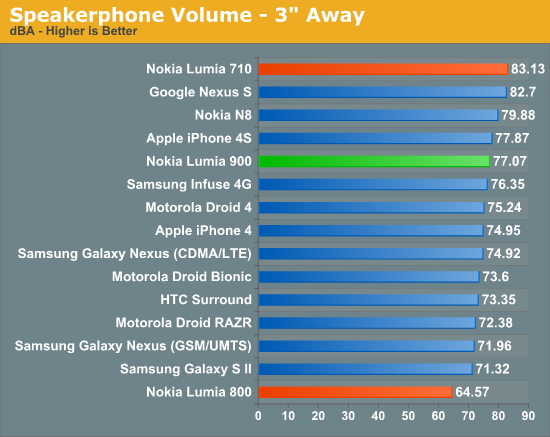
The next test is how well the Lumia 900's noise rejection works, which uses the second microphone at the very top in conjunction with the primary microphone in the speakerphone grille at bottom to do some common mode noise rejection. To test this I did what I always do and placed a call between the Lumia 900 and another AT&T phone (AMR-NB) and recorded the output of that call while increasing the volume of some music and decreasing it.
The results are excellent, as even at maximum volume I have a hard time discerning the background sound at all. I suspect that Nokia is using the Fluence noise rejection provided onboard the Qualcomm SoC, but I'm still not completely certain.


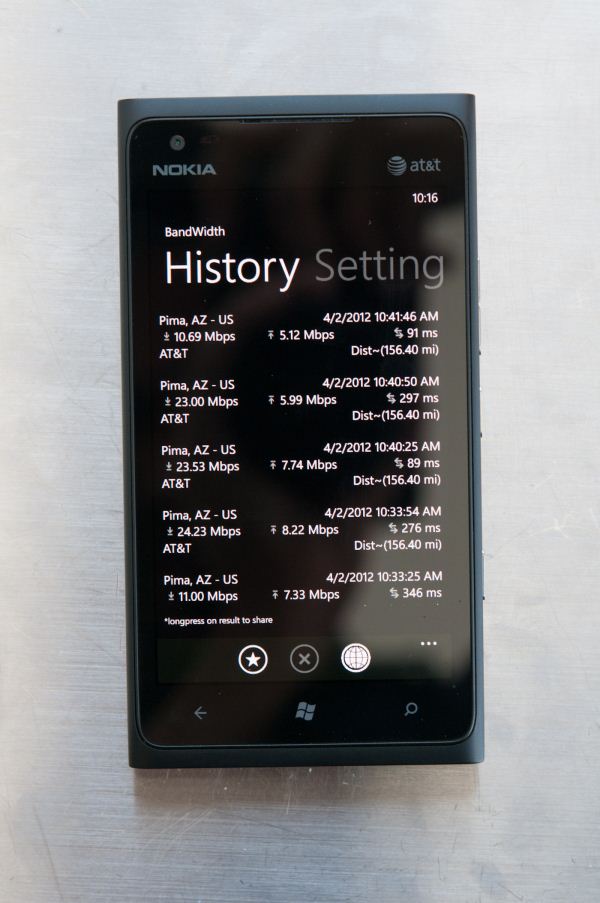
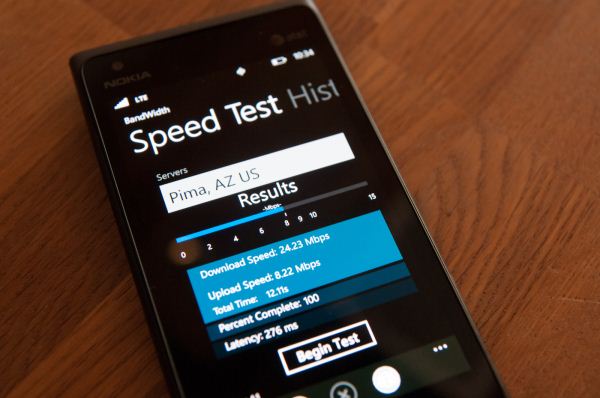
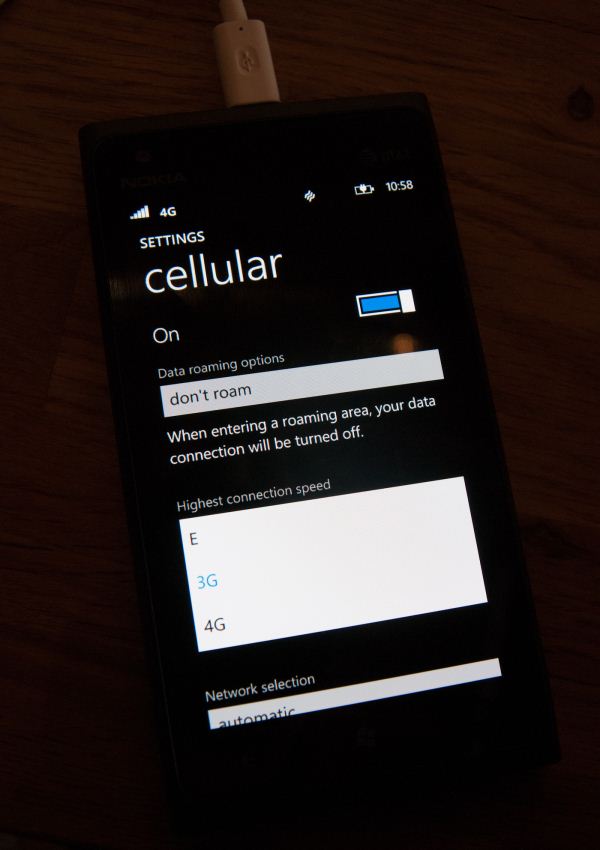
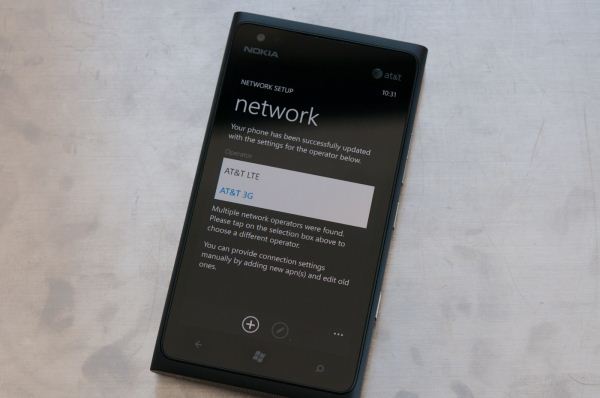








128 Comments
View All Comments
Beerfloat - Thursday, April 5, 2012 - link
Yup, I guess there's always a next best thing around the corner in the tech industry. Krait is pretty cool. But then, A15 bundled with a fast SGX or Mali GPU will be cooler still. Tegra 3 does have the benefit of the low power 5th core, plus, for right or for wrong, Nvidia always seems to bring the little extra member benefits.tipoo - Thursday, April 5, 2012 - link
True, but the Krait version of the One X isn't that far away, compared to A15 and all that. The Krait One S is already shipping. And Nvidia's fifth core doesn't help it against Kraits battery life, look at the One S with Krait, it gets significantly higher life (to be fair, some will be the screen, but still). Tegra Zone optimizations apart, Krait is nearly uniformly better.jed22281 - Sunday, April 8, 2012 - link
typical moronic response.ecuador - Wednesday, April 4, 2012 - link
If more people got their hands on the N9's it would not be a dead OS. Even people with the latest iphones are amazed when they try out the N9, something I have never seen with, say, an Android phone.That's why I complain about tech sites not trying to give the N9 the chance that Nokia did not want it to have - it is (was?) by far the most promising mobile OS (not to mention the most open).
jed22281 - Sunday, April 8, 2012 - link
Maemo6x (meego-harmattan) used by the N9 is far from being the most open.Tizen & WebOS are far more open, even Android is arguably....
If it had been given time to evolve into real MeeGo* it would've been w/o question.
There's MeeGo derivatives floating about still (MeR + Nemo/Plasma etc)
But they're more underdeveloped than they would've been, had resources not been dropped hugely in the past 14mth.
*which would've completed by July 12' at the latest w/the 1st x86 phone, after the 3rd Harmattan ph started reaching shelves.
jed22281 - Sunday, April 8, 2012 - link
typical moronic response.Tujan - Wednesday, April 4, 2012 - link
Excellent article about a cell phone from anandtech.com !...
With the exception of memory bandwidth this is certainly a great little computer radio phone.
....
"Waiting is never easy" <- catchy. !
Origin32 - Wednesday, April 4, 2012 - link
And of course half of the comments are about Android phones being slow. Yes, the UI is less smooth than iOS of WP. But I really don't care about that and I can't be the only one. In my humble opinion functionality is king, and whether my homescreen renders at 20fps or 60 doesn't really matter. Android has some great features that I am yet to see in iOS or WP. Having borrowed an iPhone for a couple hours I already found it to be incredibly constraining and the lack of a back or menu button annoyed the crap out of me. As for WP, I played around with a Lumia 800 for a while but all the sidescrolling in the homescreen and in apps was very confusing. It made the display feel too narrow.Plus, I bet you'll all be glad we have quadcore smartphones when they've become so fast you can ditch your laptop, but of course most of you never even considered that :)
valhar2000 - Wednesday, April 4, 2012 - link
People around here keep talking about the superior feature set of Android. What are these features that other phone OSs don't have?Beerfloat - Wednesday, April 4, 2012 - link
Well, HD screens for one. Grown up DPI-independent rendering for another. A choice of different form factor devices to suit various usage patterns and budgets. Multiple software stores, an enormous amount of apps, close integration with Google services (if so desired), wonderful customizability, the most straightforward interaction with other devices like PCs (it's just an USB disk drive, plus it talks CIFS).But oh well.